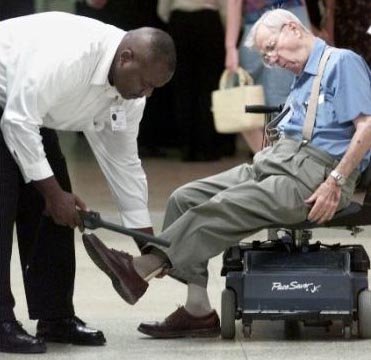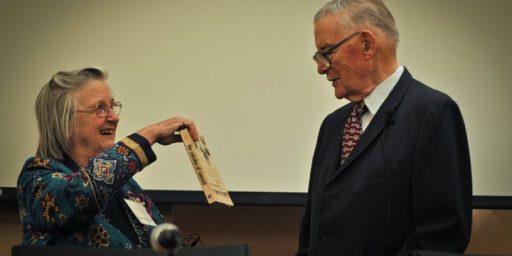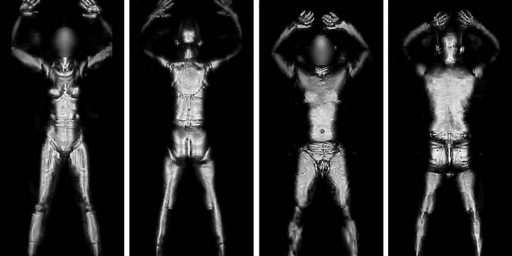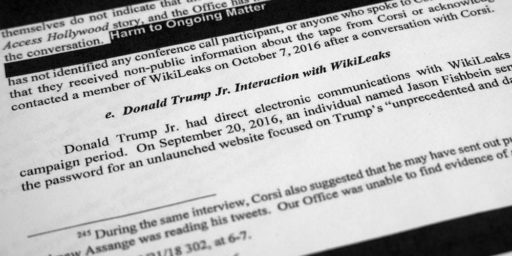TSA Publishes Airport Screening Manual
 Are you a terrorist who would like to blow up an airliner but confused about how best to elude screening? Well, luckily for you, the Transportation Security Administration has published a How To manual to answer all your questions.
Are you a terrorist who would like to blow up an airliner but confused about how best to elude screening? Well, luckily for you, the Transportation Security Administration has published a How To manual to answer all your questions.
In a massive security breach, the Transportation Security Administration (TSA) inadvertently posted online its airport screening procedures manual, including some of the most closely guarded secrets regarding special rules for diplomats and CIA and law enforcement officers.
“This shocking breach undercuts the public’s confidence in the security procedures at our airports,” said Senator Susan Collins, R-Me., ranking Republican member of the Senate Homeland Security and Governmental Affairs Committee. “On the day before the Senate Homeland Security Committee’s hearing on terrorist travel, it is alarming to learn that the Transportation Security Administration (TSA) inadvertently posted its own security manual on the Internet.”“This manual provides a road map to those who would do us harm,” said Collins. “The detailed information could help terrorists evade airport security measures.” Collins said she intended to ask the Department of Homeland Security how the breach happened, and “how it will remedy the damage that has already been done.”
The most sensitive parts of the 93-page Standard Operating Procedures manual were apparently redacted in a way that computer savvy individuals easily overcame.The document shows sample CIA, Congressional and law enforcement credentials which experts say would make it easy for terrorists to duplicate.
The improperly redacted areas indicate that only 20 percent of checked bags are to be hand searched for explosives and reveal in detail the limitations of x-ray screening machines.
[…]
The document contains a list of items for which screening is not required including wheelchairs, footwear of disabled individuals, casts and orthopedic shoes.
The redacted portions also indicate which law enforcement personnel are specially screened or exempt from some screening procedures, and indicate what requirements they must meet to be eligible for special screening.
TSA screeners are also told to require extra screening for any passenger whose passport was issued by Cuba, Iran, North Korea, Libya, Syria, Sudan, Afghanistan, Lebanon, Somalia, Iraq, Yemen or Algeria.
The document also reveals that during peak travel times, TSA screeners who check identification can reduce from 100 percent to 25 percent the times they use black lights to authenticate documents.
“Screening is like a big puzzle and this SOP gives you directions on putting the puzzle together,” said Robert MacLean, a former Federal Air Marshal who was fired for revealing holes in TSA’s security after the 9/11 attacks. MacLean added that TSA’s assertion that the documents posted are old holds no merit. “How much in screening procedure changes in 17 months?” asked MacLean. “It’s a one-dimensional process.”
The good news is that, contrary to what we’d been led to believe, TSA is in fact profiling people who come from countries considered a particular terrorist threat (although Cuba seems dated in that regard). The bad news is that they’ve published the freakin’ manual.
TSA assures us that the manual is dated but, as Ed Oswald points out, “the screening process has likely not changed that drastically that the procedures detailed here are worthless to terrorists and other interested parties.” And, frankly, since the manual is dated May 28, 2008 with an implementation date of June 30, 2008, I’m dubious of the claims that the manual is outdated.
Ed Morrissey is right, too, in assessing the implications:
Part of maintaining a security protocol is securing the protocol itself. Those wishing to breach security for whatever purpose maintain a constant watch on procedures and training, looking for chinks in the armor. Normally that takes a lot of trial and error, with plenty of risk for the malefactors for detection and capture. Overcoming that intensive dedication to lost resources would be a prime goal of any terrorist network, but especially those whose numbers have been greatly reduced by a full-blown war conducted by the US on them — primarily al-Qaeda in this instance.
The publication of this data removes the requirement to throw lots of resources against the security protocol to learn its weak points. That means that people flying now are at higher risk, thanks to the exposure of this information. It almost certainly means that TSA will have to change these procedures, which will mean longer waits at security checkpoints for the foreseeable future, as they attempt to close the breach they themselves created.
Some of what’s now been revealed would have been easy enough to guess. Presumably, al Qaeda isn’t going to send people with Saudi and Yemeni passports to blow up planes, anyway. And that a wheelchair and orthopedic shoes would likely lessen the suspicion with which you’re viewed by security officials isn’t exactly shocking — although that doesn’t mean TSA won’t now start aggressively screening wheelchair-bound grannies. Thankfully, there are seldom more than 2 or 3 of those on a flight, anyway, so the additional delays and stupidity will be modest.
Nor am I terribly concerned that photocopies of CIA credentials have been published. Presumably, people skilled enough to counterfeit them already have more useful models from which to work. And the average terrorist plotter, even those who consider themselves al Qaeda operatives, lack the skillsets to make use of this information.
More troubling is the detailed information on the limitations of screening equipment. Again, that’s information for which there were surely alternate paths for well organized terrorist cells. But would-be terrorists now have a pretty good idea of how TSA deals with those limitations.
Likely to be lost in all this:
The document also provides a glimpse of the special treatment available for governors, lieutenant governors and the mayor of Washington, D.C., as well as their spouses and family and staff.
Now, to the extent that the screening process isn’t supposed to be kabuki, this makes sense. I’m rather sure these people aren’t threats to airline security. Even if Marion Barry were still mayor, the worst that would happen is that coke dust would get into the ventilation system. Still, why are these people given “special treatment” and not, say, military personnel with security clearances and thousands of others who are just as clearly not threats?






Greetings:
I would have preferred the photo of the hijab-ed TSA Muslima searching a nun who was wearing her order’s habit.
First, I read somewhere (I thought it was the link in your tweet on this, but my memory sucks, and I’m too lazy to research it) that military folks are accorded some consideration, although likely not as much as governors and Adrian Fenty.
Second, I maintain that if your security procedures are truly effective, it doesn’t matter whether or not your targets know what they are. Virtually all of TSA’s security protocols are kabuki, and do nothing more than make key folks think that something is being done.